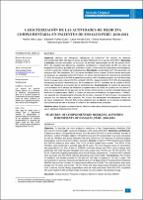| dc.contributor.author | Villar López, Martha | |
| dc.contributor.author | Ybáñez Cuba, Elizabeth | |
| dc.contributor.author | Arévalo Celis, Carlos | |
| dc.contributor.author | Astahuamán Huamán, Danna | |
| dc.contributor.author | Angulo-Bazán, Yolanda | |
| dc.contributor.author | Alarcón Pimentel, Sandra | |
| dc.date.accessioned | 2023-06-21T23:37:00Z | |
| dc.date.available | 2023-06-21T23:37:00Z | |
| dc.date.issued | 2016-04-05 | |
| dc.identifier.citation | Revista Peruana de Medicina Integrativa. 2016; 1(1). | es_PE |
| dc.identifier.uri | https://hdl.handle.net/20.500.12959/3989 | |
| dc.description.abstract | Objetivos:describir los principales indicadores de producción del servicio de Medicina Complementaria (MC) del Seguro Social de Salud (EsSalud) en el periodo 2010-2014. Materiales y métodos:estudio descriptivo, se revisaron los informes operacionales de MC del periodo 2010-2014. Se calcularon las atenciones, atendidos, rendimiento y concentración de MC, así como, las terapias individuales y grupales que se llevaron a cabo; la frecuencia de preparados farmacológicos, y la disminución del consumo de medicamentos. Resultados:se atendieron 277 270 pacientes y se realizaron 624 740 atenciones. El 71,8% de los atendidos fueron mujeres. El 39,9% de las atenciones se realizaron en pacientes entre 60-79 años. La causa más frecuente de consulta fue poliartrosis (21,5%). Se realizaron 2 392 040 terapias individuales y 54 611 terapias grupales; las más frecuentes fueron la acupuntura corporal (15,8%) y el taichí (29,3%), respectivamente. El 61,8% de preparados farmacológicos fueron neuralterápicos. Se encuestaron a 54 611 pacientes de los cuales el 50,8% reiere que disminuyó el consumo de los medicamentos. Conclusiones: el número de atenciones y de atendidos en el servicio de Medicina Complementaria ha venido en aumento en los últimos 3 años. La concentración de los servicios se ha venido uniformizando a nivel de Unidades básicas de Medicina Complementaria- UMEC y Centros de Atención de Medicina Complementaria - CAMEC. Los usuarios son frecuentemente mayores de 40 años y mujeres. El taichí chuan y la acupuntura corporal son las terapias más utilizadas. Así mismo, los preparados neuralterápicos fueron los de mayor prescripción. Más del 50% de los pacientes que se atienden en el servicio de Medicina Complementaria tienden a disminuir el consumo de medicamentos prescritos. | es_PE |
| dc.description.abstract | Objective: To describe the main production indicators of the Complementary Medicine (CM)
services from Social Health Insurance (EsSalud) in the period 2010-2014. Materials and Methods:
A descriptive study. CM operational reports, from the period 2010-2014, were reviewed. Number of
attentions, number of treated patients, CM performance and CM concentration level were calculated;
as well as individual and group therapies that were carried out; the frequency of pharmacological
preparations, and the drug consumption reduction. Results: A total of 277270 patients were treated
and 624740 attentions were made. The 71.8% of those treated were women. The 39.9% of the
attentions were performed in patients aged 60-79 years. The most frequent cause of consultation
was polyarthrosis (21.5%). A total of 2392040 individual therapy and 54611 group therapy were
performed; the most frequent therapies were body acupuncture (15.8%) and Tai Chi (29.3%). The
61.8% of pharmacological preparations were neural therapy preparations . A total of 54611 patients
were surveyed, and the 50.8% referred decreasing drug consumption. Conclusions: The number
of attentions and treated patients in CM services has been increasing in the last 3 years. The
concentration of services has been standardizing in all the Basic Units of Complementary Medicine
(BUCM) and and Care Centers of Complementary Medicine (CCCM). The most frequent users were
people over 40 years, and women. Tai Chi Chuan and body acupuncture therapies were the most
used. Likewise, neural therapy preparations were the most prescribed. More than 50% of patients
who were treated in CM services tended to reduce the consumption of prescribed drugs. | es_PE |
| dc.format | application/pdf | es_PE |
| dc.language.iso | spa | es_PE |
| dc.publisher | Seguro Social de Salud (EsSalud) | es_PE |
| dc.relation.uri | https://rpmi.pe/index.php/rpmi/article/view/687 | es_PE |
| dc.rights | info:eu-repo/semantics/openAccess | es_PE |
| dc.rights.uri | https://creativecommons.org/licenses/by-nc-sa/4.0/ | es_PE |
| dc.subject | Terapias complementarias | es_PE |
| dc.subject | Medicina tradicional | es_PE |
| dc.subject | Medicina alternativa | es_PE |
| dc.subject | Medicina alternativa | es_PE |
| dc.subject | Servicios de salud | es_PE |
| dc.subject | Complementary therapies | es_PE |
| dc.subject | Integrative medicine | es_PE |
| dc.subject | Health services | es_PE |
| dc.title | Caracterización de las actividades de medicina complementaria en pacientes del seguro social del Perú. 2010-2014 | es_PE |
| dc.title.alternative | Features of complementary medicine activities for patients of essalud , Perú. 2010-2014 | es_PE |
| dc.type | info:eu-repo/semantics/article | es_PE |
| dc.subject.ocde | https://purl.org/pe-repo/ocde/ford#3.02.29 | es_PE |
| dc.identifier.doi | https://doi.org/10.26722/rpmi.2016.11.6 | |






